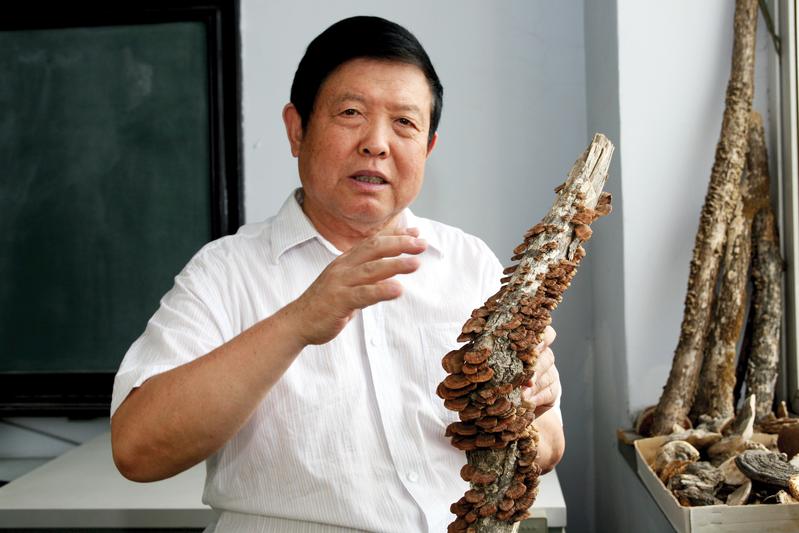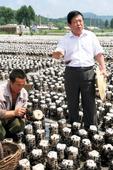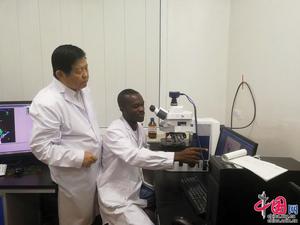 Top mycologist Li Yu exhibits a fungus specimen in Changchun, Jilin province, in 2010. (PHOTO PROVIDED TO CHINA DAILY)
Top mycologist Li Yu exhibits a fungus specimen in Changchun, Jilin province, in 2010. (PHOTO PROVIDED TO CHINA DAILY)
“I am a mushroom grower!”
The unusual self-introduction of a speaker of medium-height but sparkling eyes aroused cheerful responses from the audience in a spacious conference hall in Changsha of Central China on June 27, 2019.
The guest speaker, Li Yu, one of China’s top mycologists who had spent decades on discovering, studying, raising and popularizing fungi, was giving a briefing to a sideline forum of the First China-Africa Economic and Trade Expo about progress his teams had made in Africa.
Many were touched by his words later: “I wish locally produced edible fungi can be available across Africa.”
During a TV interview after the event, Li explained that fungi were an ideal option in building up a cyclical economy in the continent because fungi could turn agricultural waste into a reliable source of food against all odds.
It was during his first visit to Zambia in 2011 when he found local people’s interests in mushrooms, his lifelong specialty. The Chinese had been working for years and managed, in June 2011, to set up an agricultural exchange center near the University of Zambia in Lusaka. Jilin Agricultural University, where Li served as president from 1992 to 2004, was authorized for the center’s operation in 2012 and helped train over 1,180 locals in the following years.
After scrupulous studies into local conditions, Li and his assistants introduced eight species of mushrooms into Zambia that thrived in the local tropical climate with supplementary growing and processing techniques. Years later, investors from Jilin province opened processing plants with local employees. Nowadays, local people have fresh fungi to eat all year round, Li told local Changsha media.
Li’s passion was established during his graduate studies in Jilin Agricultural University from 1978 to 1981, when he learned that among roughly 500 slime mold species the world knew at the time, none had been named by a Chinese scientist despite the country having a wealth of resources. His mentor, revered mycologist Zhou Zonghuang, on his deathbed, asked him to keep studying slime molds because hardly anyone was doing it.
“He held my hand tightly while repeating his last wish, over and over again,” Li recounted. “I solemnly promised him I would continue his work and never give up.”
Though the United States and European countries were the powerhouses of research into fungi, Li relinquished his opportunity to study abroad and dived into the mountains and valleys of his home country after graduation to explore the country’s resources, conducting field inspections year in year out.
 Li, a noted mycologist and an academician of the Chinese Academy of Engineering, works with a farmer in Huangsongdian township in Jilin province on black fungus species in 2009. (PHOTO PROVIDED TO CHINA DAILY)
Li, a noted mycologist and an academician of the Chinese Academy of Engineering, works with a farmer in Huangsongdian township in Jilin province on black fungus species in 2009. (PHOTO PROVIDED TO CHINA DAILY)
On a field trip to Taibai Mountain, Shaanxi province, in 1981, Li saw bear footprints next to his feet, but with eyes on vestiges of fungi in the untamed forests, he ignored fresh animal droppings on the trail, only to learn soon afterwards of a wild bear roaming nearby at that time. “It was the scariest moment of my life,” Li said.
Despite danger in the wildness, his passion sustains and is passed on. For decades, Li would regularly take his doctoral students on hiking trips up mountains, get battered by the elements, cross turbulent streams, and crawl in the soil just to take a good photo of the fungi specimen in its natural habitat.
Over the years, Li and his teams have collected more than 12,000 fungi specimens and contributed greatly to the taxonomy of the species in China. He succeeded in naming 36 slime mold species, fulfilling his mentor’s dream.
However, Li harbors a belief: “Scientists, especially agricultural scientists, should not farm on the blackboard.” What he means is that the scientists should get their feet in the field and use their research to help farmers become rich and live better lives.
A golden time dawned for him when the central leadership of China announced in late 2012 the goal of achieving an all-around xiaokang, or moderately prosperous, society by 2020. In 2012, 98.99 million rural Chinese still lived in poverty by current standards.
“Fungi are almost perfect for helping rural poverty alleviation,” Li kept telling decision-makers and followers. “This is because growing fungi is not labor, time or resource-intensive work. They are easy to plant, require little investment, grow very fast and yield good financial returns, hence it is a first-choice industry for poverty alleviation.”
Li likes to share his fascination about how the Chinese character for fungi is formed with an upper part meaning grass or plants, and a lower component meaning granary. “This means our ancestors somehow knew that fungi can be a great source of food when creating the character.”
Indeed, “edible fungi are an excellent source of fiber, vitamins and protein, making them a healthy addition to your staple diet, especially for vegetarians”.
Now agricultural waste such as plant stalks and animal manure can be turned into fertile bags of nutrients for growing fungus, he said. After they are harvested, what is left in the bags can be processed into fertilizer, effectively turning trash into treasure.
“This will build a sustainable cycle in which farmers get extra income from waste, consumers get tasty and healthy fungi products and the environment is cleaned in the process. It is like killing multiple birds with one stone.”
Thanks to the research he has undertaken, Li has developed over 300 new fungi cultivation techniques since 2012, along with 45 new breeds of edible fungi that played a key role in alleviating poverty in Hebei, Anhui, Guizhou and other provinces around China.
 Li with a foreign student at Jilin Agricultural University in 2019. (PHOTO PROVIDED TO CHINA DAILY)
Li with a foreign student at Jilin Agricultural University in 2019. (PHOTO PROVIDED TO CHINA DAILY)
Li, his students and other professionals in the national fungi association have spent most of their time since 2012 in 40 deeply impoverished regions in seven provinces to introduce fungi species, and teach villagers how to use modern equipment and techniques to cultivate them.
One of them is Jinmi village in Zhashui county, Shaanxi province. Xiao Qingson, 41, had been working on construction sites for years when he was approached by local officials in October 2018 about returning home to grow new strains of fungus.
However, Xiao was skeptical of planting the new crops that came in white cylinder bags filled with organic compost and punctured with holes. It was a far cry from his perception of fungi growing on tree trunks.
“I grew fungus before. It is very hard work and the yield depends heavily on precipitation. I didn’t make much money,” he said.
After some encouragement, Xiao planted about 40,000 bags of the fungus in 2019. To his surprise, the yield was high and the fungus was very palatable. He made more than 30,000 yuan in the same year.
“I won’t dare dream of earning so much money in my hometown before,” Xiao said. “Now my life is improving day by day, I may even get to buy a small sedan later.”
In April 2020, President Xi Jinping visited Jinmi and examined automated fungi farms cultivated with the support of Li’s team. Rows of nutrient-filled mesh bags in a greenhouse are equipped with high-definition cameras, sensors and automatic ventilation and irrigation systems.
The technologies enabled local farmers to sustain high yields despite the impact of the COVID-19 epidemic. The county’s fungi industry produces around 3,750 metric tons of dried wood ear mushrooms annually, valued at 300 million yuan, which helped it climb out of poverty a year earlier.
Xi was impressed by the work, calling it “small wood ear, big industry”.
According to the China Edible Fungi Association, the country produced around 58,000 tons of edible fungi in 1978. By 2019, production had soared to over 39.34 million tons and the industry was worth more than 312.6 billion yuan (US$47.8 billion), becoming China’s fifth-biggest agricultural sector after grain, oil, fruit and vegetables. The same year, China produced over 70 percent of the world’s edible fungi.
On Feb 25, Xi announced in Beijing that all 98.99 million people and 832 poverty-stricken counties in the country were lifted out of extreme poverty. Li was aware that 70 to 80 percent of the counties chose to farm edible mushrooms like black fungus as one of the main channels to get rid of poverty. Xi presented Li with a national honorary title for his poverty eradication work.
Li’s passion for fungi is stoked alive. The 77-year-old has named his granddaughter “Mu’er”, which means “black fungus”. He hopes younger generations can carry on his work. In the last 30 years, Li has trained over a hundred master’s and doctorate degrees students, many of which have become leading experts in the fungus industry.
His fungus dream also goes on in Africa. Apart from Zambia, more varieties developed by his teams and fit for specific conditions in the continent are flourishing in Nigeria and Ghana, while related product packages are entering more countries.
Xinhua, Huasheng Online, China Education Daily and People’s Daily contributed to this story.


